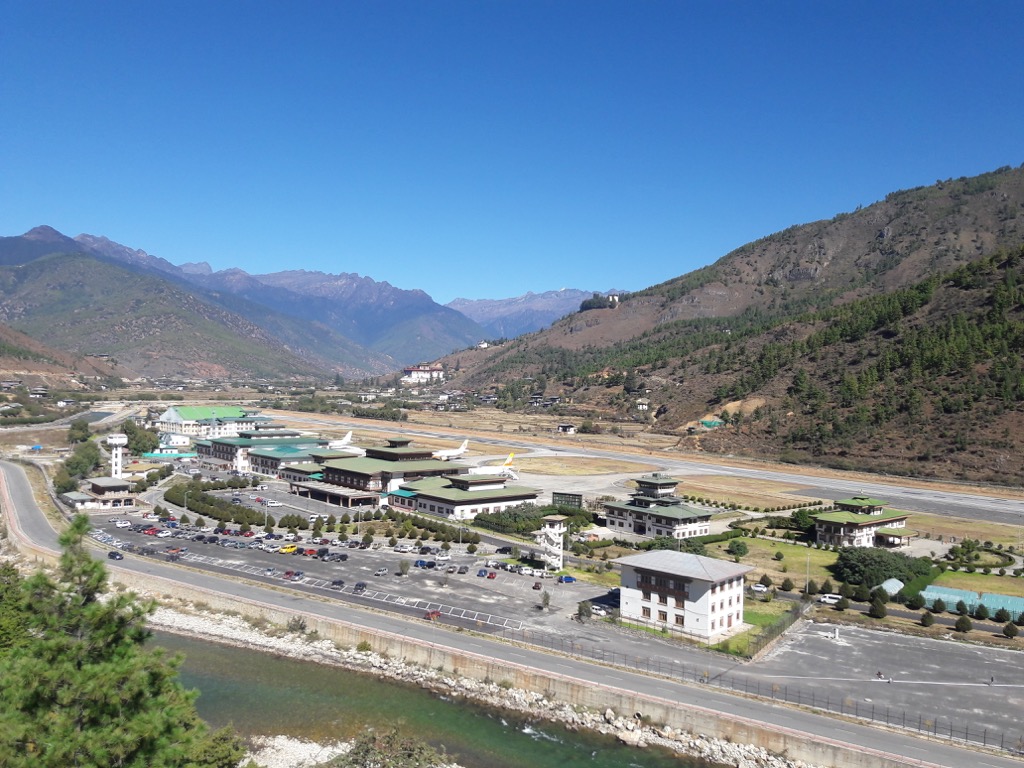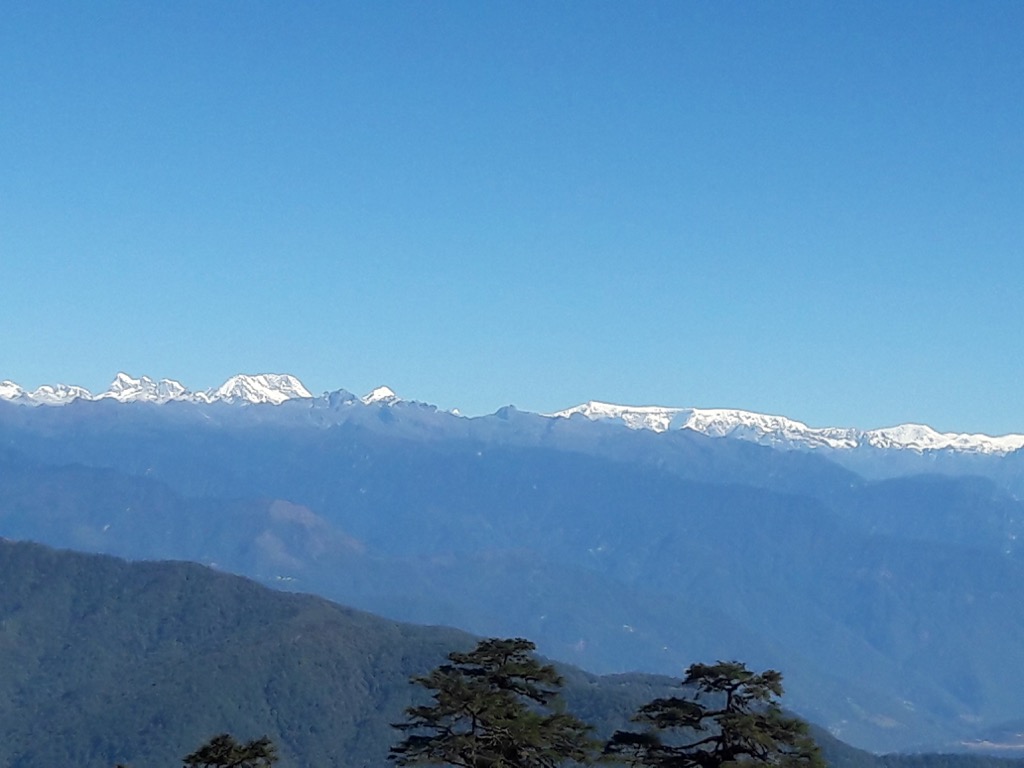Dochula Druk Wangyel Festival Tours
|
|
The Dochula Druk Wangyel Festival was established in 2011 in commemoration of His Majesty the Fourth Druk Gyalpo and the Armed Forces’ victory over Indian insurgent forces residing in southern Bhutan in 2003.
The festival is held annually on December 13th at the Festival Ground near Druk Wangyel Lhakhang which is located at Dochula Pass. Dochula Pass is one of the most scenic passes in Bhutan, which offers spectacular views of the Himalayan mountain ranges. Druk Wangyal Lhakhang (temple) was built over period of four years from 2004-2008 by Ashi Dorji Wangmo Wangchuck ( the Queen Mother of Bhutan) as a tribute to His Majesty the fourth King of Bhutan, Jigme Singye Wangchuck and armed forces after His Majesty led a successful operation against Indian militants who had occupied certain areas of Bhutan. The gallery of the Druk Wangyal Lhakhang has beautiful murals depicting some of the important events in the reigns of the Kings of Bhutan.

This 7 night 8 day tour program also includes visits to culturally rich valleys of Western Bhutan such as Paro, Thimphu, Punakha, Wangduephodrang and Phobjikha.
7 Night 8 Day Tour Itinerary
Day 1 Arrive Paro
If you arrive on a bright sunny day, your holiday began with the panoramic view of the Himalaya range from your flight seat, you will be greeted by Mt. Everest and Mt. Kanchenjunga, and our very own Mt.Jomolhari and Mt.Jichu Drakey. An unparalleled feeling while you are descending over Bhutan is a feeling which is of total abandonment, a feeling which is inexplicably, compassionate and full of suspense as visibly seen in the growing communion between the passengers.
Upon arrival you will be received by our guide who will help you settle into your comfortable car.
Rinpung Dzong,built in 1645 to defend the valley against Tibetan invaders. The Dzong is now being used as an administration center and school for monks.Then walk down to Rimpung Bridge (Traditonal Bridge), oldest bridge in Bhutan.
Farm housesin Paro Valley and a visit to a farm house offers a good glimpse into the lifestyle of a farmer.
TaDzong
One time watch tower built to defend Rinpung Dozng during inter-valley wars of the 17th century, since 1967 Ta Dzong is serving as the National Museum of the country. It holds fascinating collection of art, relics, religious thangkha paintings and Bhutan’s exquisite postage stamps. The museum circular shape augments its varied collection displayed over several floors.
Overnight at a hotel in Paro
Day 2 Hike to Tiger’s Nest & Paro to Thimphu (54 km-1 hour drive)
After breakfast, hike up to Taktsang Monastery, also known as ‘Tiger’s Nest’. The climb up to the viewpoint will take around 1 ½ hours and from there you will enjoy a spectacular view of the monastery clinging to the side of the cliff. Stop for refreshment at the View Point Cafeteria.Then walk further up to the monastery which will take about 1 hour. It is said that in the 8th century Guru Rinpoche flew on the back of a tigress from eastern Bhutan to this place and meditated in a cave here for 3 months. The principal Lhakhang (monastery) of the present monastic complex dates from 1692. Taktsang was damaged severely by fire in 1998 but has now been fully restored to its former glory.After visiting the monastery, walk back down to the road on the way stop for lunch at the view point cafeteria and then walk further down to the road point. On the way, visit Kyichu temple,one of the 108 temples built in the 7th century by the Tibetan King Songsten Gampo. The story goes that a giant demon lay across the whole area of Tibet and the Himalayas and was preventing the spread of Buddhism. To overcome her, King Songtsen Gampo decided to build 108 temples, which would be placed on all the points of her body. Of these 108 temples, 12 were built in accordance with precise plans.
Then drive back to Thimphu.
Overnight at a hotel in Thimphu.
Day 3 Dochula Druk Wangyel Festival
After breakfast drive for about 45 minutes to Dochula Pass (3140 m) to attend the Druk Wangyel Festival. In the clear winter sky you will get to enjoy the panoramic view of the Himalayan Mountain ranges.
Dochula Druk Wangyel Festival program
- Azhe Lham (Folk Dance)
- Dance of Gadpo Ganmo (mask dance)
- Neyang Dochula written by karma Ura (Folk dance) or Dance of Jetsun Milarepa and Tsering Chednga.
- Part I. Jetsun Milarepa and Five Enchantresse (Mask dance)
- Pawo Palden Drukpa written by HH Je Khenpo (Folk dance)
- Part II. Jetsum Milarepa and Five Enchantresses (Mask dance)
- Part III: Jetsun Milaraepa and Tshering Chednga (Mask dance)
- Neladangpamichag by HH Je Khenpo (Folk dance)
- Gakid Palzom by Gonpo Tshering (Folk dance)
- Ngonjon Gyalwagongma (Folk dance)
- Phodrang Dangpa Michag Folk dance)
- Gyalwa Shacha Muni written by Gonpo Tshering (Folk Dance) Dance of the Heroes.
- Part I. Farewell of the Heroes (Folk dance)
- Druk Puna Dechen (Folk dance)
- Luchochig Lhadangsungma Chod by HH Je Khenpo (Folk dance)
- Part II. Combat of the Heroes (Mask dance)
- Lha Ugyen Pema by Gonpo Tshering (Folk dance)
- Sharitseney by HH Je Khenpo (Folk dance)
- Kidpu Drukgyi Tsenden By HH Je Khenpo (Folk dance)
- Part III: return of the Heroes and Encounter with Boddhisattvs (Mask dance)
- Tashi Labey ( Farewell folk dance)
- After the festival drive to Punakha which about 2 hours drive from Dochula.
Dinner and overnight at a hotel in Punakha.
Day 4 Punakha Sightseeing
After breakfast, drive through upper Punakha valley and take a hike through farmhouses to the beautiful Khamsum Yuelley Namgyal Lhakhang (temple) built by Ashi Tshering Yangdon Wangchuck (the Queen Mother of Bhutan) for peace and stability in this ever-changing world. This temple is situated on the hilltop overlooking the valley below. The leisurely walk up to the temple would take about an hour. Visit the temple and also enjoy the breathtakingly beautiful view from there.
Punakha Dzong
Placed strategically at the junction of the Pho Chu and Mo Chu rivers, the dzong was built in 1637 by Zhabdrung Ngawang Namgyal to serve as the religious and administrative seat of the region. It was here that the dual system of government was introduced in the 17th century and in 1907, enthroned the first King Gongsar Ugyen Wangchuck. Damaged over the centuries by four catastrophic fires and an earthquake, the dzong has been fully restored in the recent years by the 4th King Jigme Singye Wangchuck. At the dzong enrich your trip with the opportunity to see the highest standards in woodwork. Do not miss the massive Kuenray, the Coronation Hall of all Bhutanese kings, the Dzongchung at the entrance to the dzong and the cantilever bridge over the Mochu that has been recently renovated.
Chimi Lhakhang
The Chimi Lhakhang, situated on a hillock in the centre of the valley, is dedicated to Lama Drukpa Kuenley, who in the late 15th century used humour, songs and outrageous behavior to dramatise his teachings and due to this also known as “Divine Madman”. This temple is also known as the temple of fertility. It is widely believed that couples who do not have children and wanting one, if they pray at this temple, they are usually blessed with a child very soon. It is about 30 minute walk across field from the road to the temple. The trail leads across rice fields to the tiny settlement of Pana, meaning “field”. It then follows a tiny stream downhill to Yoaka and across more fields before making a short climb to Chimi Lhakhang.
In the evening you may visit Rinchengang village in Wangduephodrang where you will take a short hike through the village and have free interaction with the villagers. Round trip hike will take about 1 hr. At the same time you can view the ruins of Wangdue Dzong (the Dzong was razed to the ground by fire in 2012).
Dinner and overnight at a hotel in Punakha.

Day 5 Punakha-Phobjikha-Punakha (64 km-3 hours drive)
After breakfast drive to Phobjikha valley through the dense forests of the Phobjikha Valley you arrive at Gantey village where you see the Gangtey Monastery and visit the monastery. Phobjikha valley is part of the beautiful Jigme Singye Wangchuck National Park ( formerly known as Black Mountains National Park), one of Bhutan’s most important nature sanctuaries. Each winter it is home to a flock of 300 rare and endangered black-necked cranes. The surrounding hills and mountains are home to nomadic shepherds and yak-herders. This is one of the most remote and untouched regions in Bhutan and is only just opening its doors to the outside world.
The Black necked cranes start migration to this area from November each year. You will have refreshment and lunch at a resort/restaurant in this valley. Afternoon you can visit the Black Necked Crane Center and enjoy the fascinating sight of these birds in this beautiful scenic valley.
In the late afternoon drive back to Punakha and overnight at a hotel in Punakha.
Day 6 Punakha-Thimphu (77 km-3 hours drive)
After breakfast,drive to Thimphu and after lunch visit the following.
Traditional Bhutanese paper making factory. The handmade paper making in Bhutan stemmed from the age old tradition originated in 8th century of Bhutanese history. The handmade paper constitutes as valuable National heritage of Bhutanese cultural identity and is preserved through all the ages. The Traditional paper is recognized and held high esteem both in home and outside world. Jungshi Paper Factory was established in November 1990 as an undertaking of the Royal Government of Bhutan. The unit now boasts as a major and sole dealer in handmade paper and its products.
National Textile Museumwhich is a good place to see the art of traditional weaving being kept alive and preserved through exhibition and has a good collection of old textiles which are rich in colors and designs.You will also see people weaving with intricate designs.
School of Traditional Painting of Arts and Craftswhere students undertake a six-year course on the 13 traditional arts and crafts of Bhutan.
National Memorial Chorten,chorten literally means ‘ seat of faith’ and Buddhists often call such monuments the ‘Mind of Buddha’. Meet the elderly local in circumambulation at the National Memorial Chorten.
Tashichhoe Dzong, a fortress of the glorious religion. It was built in 1641 by Zhabdrung Ngawang Namgyel and was reconstructed into present structure by the late King, His majesty Jigme Dorji Wangchuck in the year 1962-1969. It houses the secretariat building, the throne room and the office of the king, and the central monk body.
Overnight at a hotel in Thimphu.
Day 7 Thimphu Sightseeing and Thimphu-Paro (54km-1 hour drive)
Takin Preserve, which houses the national animal the Takin that is only found in Bhutan. This is an extremely rare member of the goat family. Found in herds in the very high altitudes (13,125ft and over). They live on a diet of grass and bamboo. It can weigh as much as 550 pounds.
Witness Archery game which is National sport of Bhutan.
Buddha Point (Kuensel Phodrang)
Located at a short drive from Thimphu city centre, visitors can get a good overview of the Thimphu valley from the Buddha point (Kuensel Phodrang). You can pay your obeisance and offer prayers to the Buddha, the largest statue in the country and then walk around and take a glimpse of the valley.
In the late afternoon drive to Paro.
Dinner and overnight at a hotel in Paro.
Day 8 Departure from Paro
In the morning,your guide will escort you to the airport for your flight onwards.